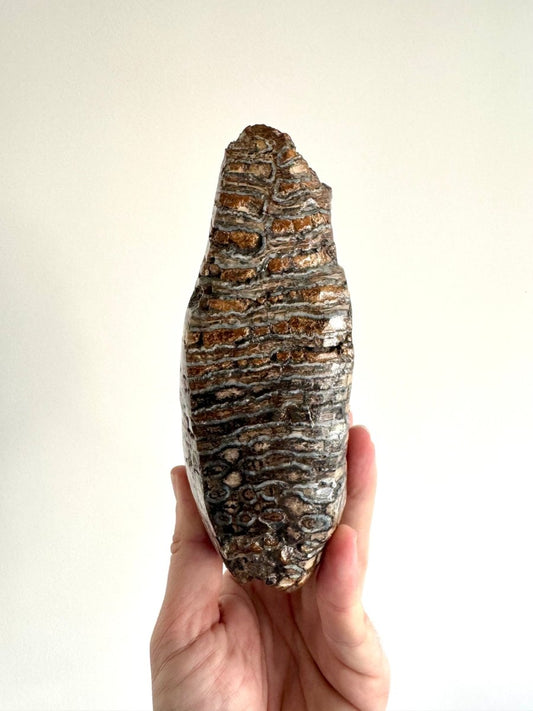Collection: Mammoth fossils for sale
The mammoth was an iconic Ice Age giant. Towering up to 13 feet at the shoulder, with curving tusks that could reach over 16 feet, these herbivores roamed across Eurasia, North America, and Africa. Covered in a dense fur coat, adapted for frigid climates, mammoths exhibited remarkable social behaviors.
Sadly, mammoths faced extinction around 10,000 years ago, with factors like climate change and human influence contributing to their decline.
-
Mammoth Primigenius hair in picture frame - Pleistocene Period, Siberia (A003)
Regular price €28,95 EURRegular priceUnit price / per -
Mammoth Primigenius hair in picture frame - Pleistocene Period, Siberia (A002)
Regular price €28,95 EURRegular priceUnit price / per -
2.6 KG Mammoth Molar, Permafrost, Jakutia
Regular price €450,00 EURRegular priceUnit price / per -
1.5 KG Mammoth Primigenius Molar, Bruine bank, North Sea
Regular price €220,00 EURRegular priceUnit price / per -
Mammoth Primigenius hair in picture frame - Pleistocene, Siberia (nr4)
Regular price €28,95 EURRegular priceUnit price / per -
Mammoth Primigenius hair in picture frame - Pleistocene, Siberia
Regular price €28,95 EURRegular priceUnit price / per -
Mammoth Primigenius Molar (3.78") - Pleistocene, Holland
Regular price €69,95 EURRegular priceUnit price / per -
Mammoth Primigenius Molar (3.14") - Pleistocene, Holland
Regular price €69,95 EURRegular priceUnit price / per -
Mammoth Primigenius Molar (3.15") - Pleistocene, Holland
Regular price €69,95 EURRegular priceUnit price / per -
Mammoth Primigenius Molar (5.50") - Pleistocene, Holland
Regular price €75,00 EURRegular priceUnit price / per
About the Mammoth
The mammoth, scientifically known as Mammuthus, is an extinct genus of elephant that roamed the Earth during the Pleistocene epoch, approximately 4.8 million to 10,000 years ago. These iconic creatures were among the largest land mammals to have ever lived, known for their long, curved tusks, massive size, and thick, shaggy coats.
Physical Characteristics
Mammoths were characterized by their large size, with some species reaching heights of up to 13 feet (4 meters) at the shoulder and weighing several tons. They had long, curved tusks that could grow up to 15 feet (4.5 meters) in length, which were used for digging, foraging, and display. Their bodies were covered in thick fur, adapted to the cold climates of the Pleistocene, and they had a hump of fat on their backs for energy storage during harsh winters.
Habitat and Distribution
Mammoths inhabited a wide range of environments, including grasslands, tundra, and boreal forests, across North America, Eurasia, and parts of Africa. They were well-adapted to cold, temperate climates and could withstand harsh winters thanks to their thick fur and layers of fat. Mammoth fossils have been found in various locations around the world, with some of the most well-preserved specimens discovered in permafrost regions of Siberia.
Diet and Behavior
Mammoths were herbivores, primarily feeding on grasses, shrubs, and other vegetation. Their diet varied depending on the season and the availability of food in their environment. Mammoths lived in herds, which provided protection from predators and allowed for social interaction and mating. They were intelligent and social animals, capable of forming complex social structures and communicating with one another through vocalizations and body language.
Extinction and Legacy
Mammoths became extinct at the end of the Pleistocene epoch, around 4,000 years ago, likely due to a combination of factors including climate change, habitat loss, and human hunting. The last surviving populations of mammoths were isolated on islands such as Wrangel Island in the Arctic Ocean, where they persisted until relatively recent times. Mammoths hold a special place in human history and culture, appearing in ancient cave paintings, myths, and folklore around the world.
Scientific Study and Research
Mammoths have been the subject of extensive scientific study and research, providing valuable insights into the ecology, evolution, and extinction of Ice Age megafauna. Advances in paleontology, genetics, and molecular biology have allowed scientists to extract DNA from mammoth remains and study their genetic relationships with modern elephants. Efforts to clone mammoths using genetic engineering techniques are ongoing, with the goal of bringing these iconic creatures back to life through de-extinction projects.
Mammoths are iconic symbols of the Ice Age, representing the majestic megafauna that once roamed the Earth. Through their impressive size, unique adaptations, and profound ecological impact, mammoths continue to captivate the imagination of scientists and enthusiasts alike, inspiring further research and exploration into the mysteries of our planet's ancient past.
Mammoth fossils for sale




















